How Does a Regional Climate Model Modify the Projected Climate Change Signal of the Driving GCM: A Study over Different CORDEX Regions Using REMO
Abstract
:1. Introduction
2. Model and Experiment Setup
2.1. MPI-ESM
2.2. MPI-ESM Experiments
2.3. REMO
| Model Version | Vertical Coordinates/Levels | Advection Scheme | Timestep | Convection Scheme | Radiation Scheme | Turbulent Vertical Diffusion | Cloud Microphysics Scheme | Land Surface Scheme |
|---|---|---|---|---|---|---|---|---|
| REMO2009 hydrostatic | hybrid / 27–31 | Semi-lagrangian | 240 s | Tiedtke [49], Nordeng [50], Pfeifer [51] | Morcrette et al. [52], Giorgetta [53] | Louis [54] | Lohmann and Roeckner [55] | Hagemann [56], Rechid et al. [57] |
2.4. REMO Experiments
3. Analysis Methodology
| Climate | Köppen-Trewartha | Definition |
|---|---|---|
| Tropical humid | Ar | All months above 18 and less than 3 dry months |
| Tropical wet-dry | Aw | Same as Ar, but 3 or more dry months |
| Dry arid | BW | Annual precipitation P (in cm) smaller, or equall to |
| Dry semi-arid | BS | Annual precipitation P (in cm), greater than |
| Subtropical summer-dry | Cs | 8–12 months above 10 , annual rainfall less than 89 cm and dry summer |
| Subtropical summer-wet | Cw | Same thermal criteria as Cs, but dry winter |
| Subtropical humid | Cr | Same as Cw, with no dry season |
| Temperate oceanic | Do | 4–7 months above 10 and the coldest month above 0 |
| Temperate continental | Dc | 4–7 months above 10 and the coldest month below 0 |
| Sub-arctic oceanic | Eo | Up to 3 months above 10 and the coldest month above −10 |
| Sub-arctic continental | Ec | Up to 3 months above 10 and the coldest month below or equal to −10 |
| Tundra/Highland | FT | All months below 10 |
| Ice cap | FI | All months below 0 |
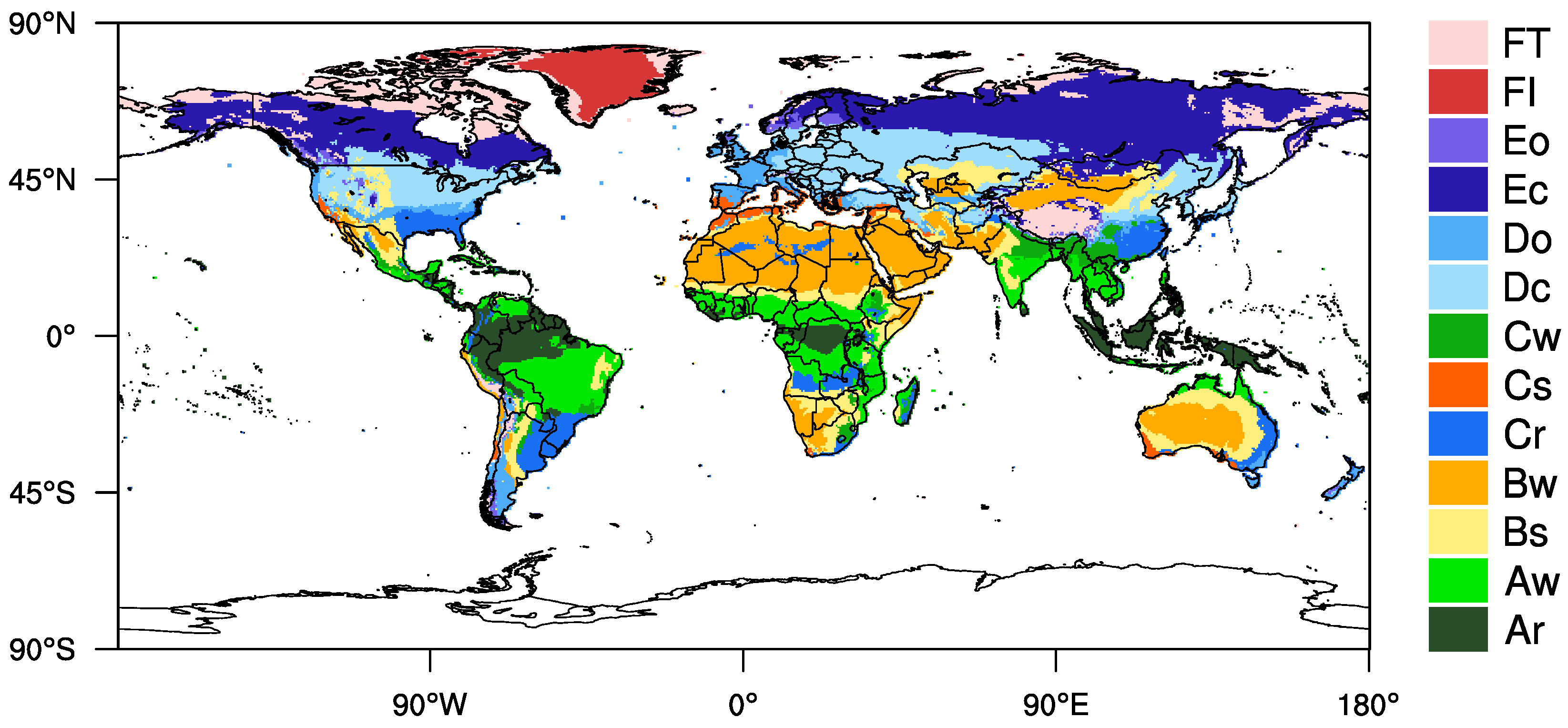
4. Results and Discussion
4.1. Evaluation of the Simulated Historical Climate
4.1.1. Temperature
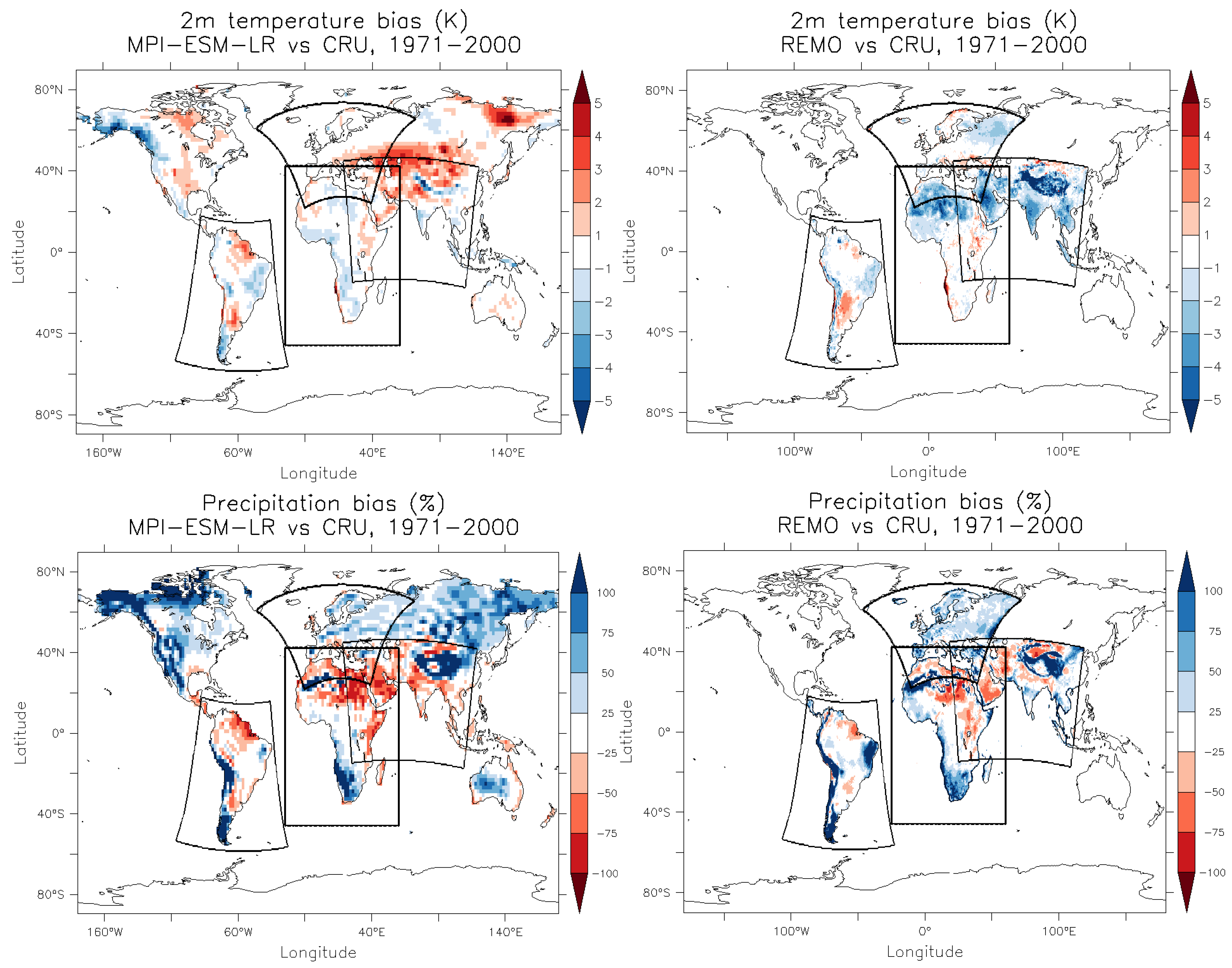
4.1.2. Precipitation
4.1.3. Discussion
4.2. Global and Regional Climate Change Signals
4.2.1. Temperature
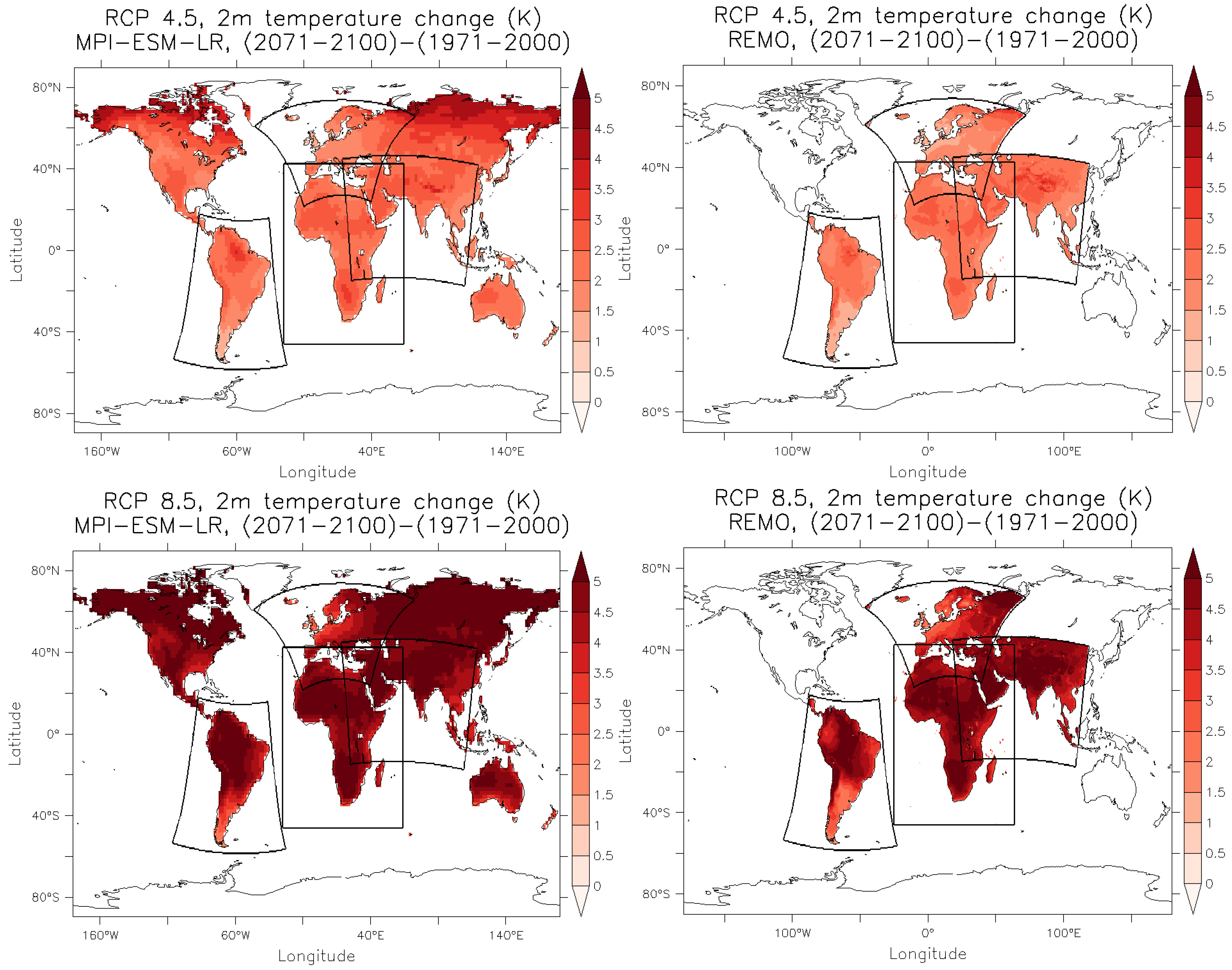
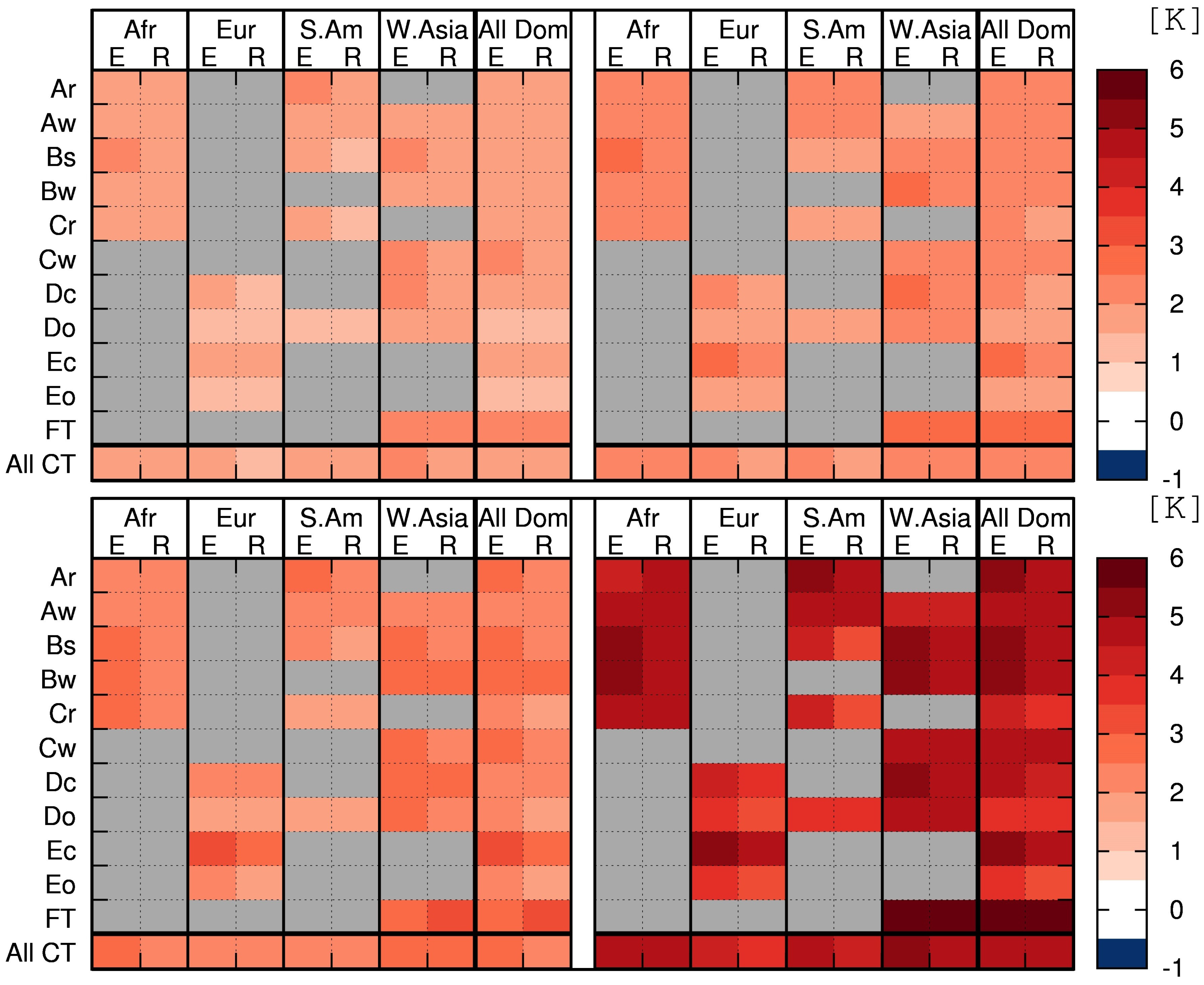
4.2.2. Precipitation
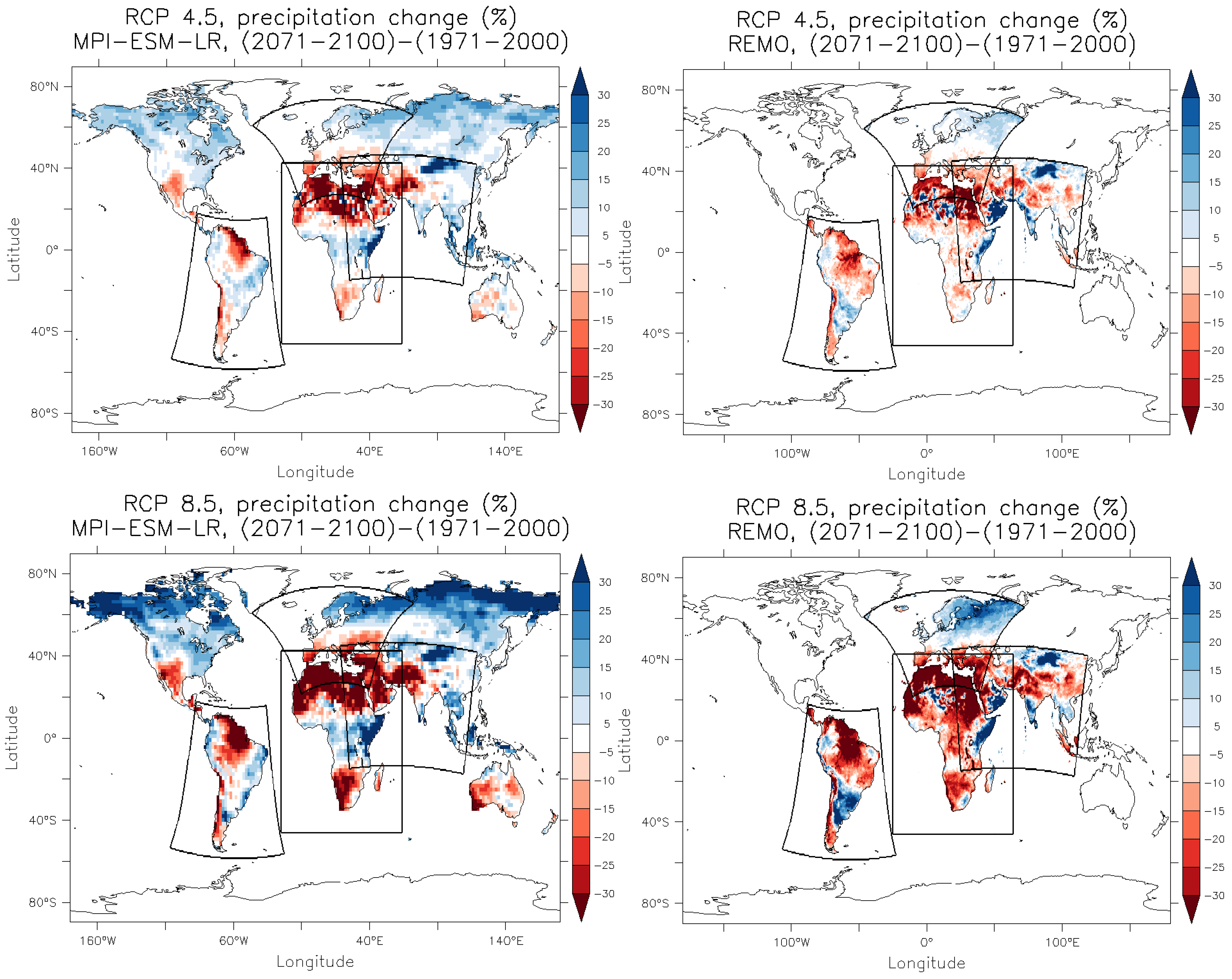
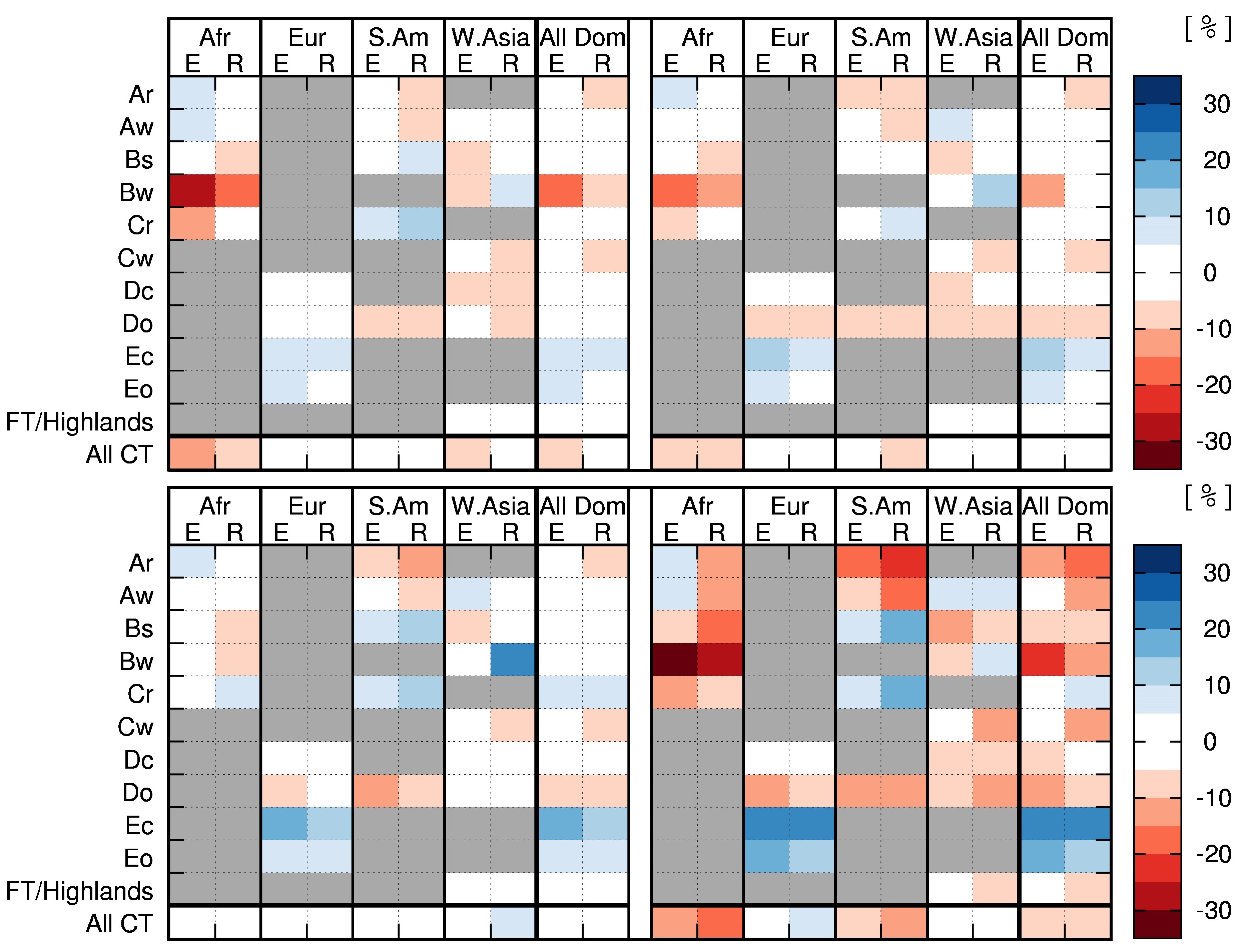
4.2.3. Discussion
5. Conclusions
Acknowledgments
Conflict of Interest
References
- Intergovernmental Panel on Climate Change (IPCC). Climate Change 2007: The Physical Science Basis. Contribution of Working Group I to the Fourth Assessment Report of the Intergovernmental Panel on Climate Change; Cambridge University Press: Cambridge, UK/New York, NY, USA, 2007; p. 996. [Google Scholar]
- Chen, H.; Sun, J.; Chen, X.; Zhou, W. CGCM projections of heavy rainfall events in China. Int. J. Climatol. 2012, 32, 441–50. [Google Scholar] [CrossRef]
- Choi, K.S.; Cha, Y.M. Change in future tropical cyclone activity over the western North Pacific under global warming scenario. Nat. Hazards 2012, 64, 1125–1140. [Google Scholar] [CrossRef]
- Brown, J.; Moise, A.; Delage, F. Changes in the South Pacific convergence zone in IPCC AR4 future climate projections. Clim. Dyn. 2012, 39, 1–19. [Google Scholar] [CrossRef]
- Brown, J.; Power, S.; Delage, F.; Colman, R.; Moise, A. Evaluation of the South Pacific Convergence Zone in IPCC AR4 climate model simulations of the twentieth century. J. Clim. 2011, 24, 1565–1582. [Google Scholar] [CrossRef]
- McAfee, S.; Russell, J.; Goodman, P. Evaluating IPCC AR4 cool-season precipitation simulations and projections for impacts assessment over North America. Clim. Dyn. 2011, 37, 2271–2287. [Google Scholar] [CrossRef]
- Ashfaq, M.; Shi, Y.; wen Tung, W.; Trapp, R.; Gao, X. Suppression of south Asian summer monsoon precipitation in the 21st century. Geophys. Res. Lett. 2009, 36, L01704. [Google Scholar] [CrossRef]
- Haensler, A.; Hagemann, S.; Jacob, D. The role of the simulation setup in a long-term high-resolution climate change projection for the southern African region. Theor. Appl. Climatol. 2011, 106, 153–169. [Google Scholar] [CrossRef]
- Karmalkar, A.; Bradley, R.; Diaz, H. Climate change in Central America and Mexico: Regional climate model validation and climate change projections. Clim. Dyn. 2011, 37, 605–629. [Google Scholar] [CrossRef]
- Karmalkar, A.V.; Bradley, R.S.; Diaz, H.F. Climate change scenario for Costa Rican montane forests. Geophys. Res. Lett. 2008, 35, L11702. [Google Scholar] [CrossRef]
- MacKellar, N.C.; Hewitson, B.C.; Tadross, M.A. Namaqualand’s climate: Recent historical changes and future scenarios. J. Arid Environ. 2007, 70, 604–614. [Google Scholar] [CrossRef]
- Chou, S.; Marengo, J.; Lyra, A.; Sueiro, G.; Pesquero, J.; Alves, L.; Kay, G.; Betts, R.; Chagas, D.; Gomes, J.; Bustamante, J.; Tavares, P. Downscaling of South America present climate driven by 4-member HadCM3 runs. Clim. Dyn. 2012, 38, 635–653. [Google Scholar] [CrossRef]
- Marengo, J.; Chou, S.; Kay, G.; Alves, L.; Pesquero, J.; Soares, W.; Santos, D.; Lyra, A.; Sueiro, G.; Betts, R.; et al. Development of regional future climate change scenarios in South America using the Eta CPTEC/HadCM3 climate change projections: Climatology and regional analyses for the Amazon, São Francisco and the Paraná River basins. Clim. Dyn. 2012, 38, 1829–1848. [Google Scholar] [CrossRef]
- Vigaud, N.; Roucou, P.; Fontaine, B.; Sijikumar, S.; Tyteca, S. WRF/ARPEGE-CLIMAT simulated climate trends over West Africa. Clim. Dyn. 2011, 36, 925–944. [Google Scholar] [CrossRef]
- Jacob, D.; Bärring, L.; Christensen, O.B.; Christensen, J.H.; de Castro, M.; Déqué, M.; Giorgi, F.; Hagemann, S.; Hirschi, M.; Jones, R.; et al. An inter-comparison of regional climate models for Europe: Model performance in present-day climate. Clim. Chang. 2007, 81, 31–52. [Google Scholar] [CrossRef]
- Inatsu, M.; Kimoto, M. A scale interaction study on east asian cyclogenesis using a general circulation model coupled with an interactively nested regional model. Mon. Wea. Rev. 2009, 137, 2851–2868. [Google Scholar] [CrossRef]
- Gomez, E.S.; Somot, S.; Deque, M. Ability of an ensemble of regional climate models to reproduce weather regimes over Europe-Atlantic during the period 1961–2000. Clim. Dyn. 2009, 33, 723–736. [Google Scholar] [CrossRef]
- Mariotti, L.; Coppola, E.; Sylla, M.B.; Giorgi, F.; Piani, C. Regional climate model simulation of projected 21st century climate change over an all-Africa domain: Comparison analysis of nested and driving model results. J. Geophys. Res. 2011, 116, D15111. [Google Scholar] [CrossRef]
- Christensen, J.H.; Carter, T.R.; Giorgi, F. PRUDENCE employs new methods to assess European climate change. Eos. Trans. AGU 2002, 83, 147–147. [Google Scholar] [CrossRef]
- Hewitt, C.D. Ensembles-based predictions of climate changes and their impacts. Eos. Trans. AGU 2004, 85, 566–566. [Google Scholar] [CrossRef]
- Giorgi, F.; Diffenbaugh, N.S.; Gao, X.J.; Coppola, E.; Dash, S.K.; Frumento, O.; Rauscher, S.A.; Remedio, A.R.; Sanda, I.S.; Steiner, A.; et al. The regional climate change hyper-matrix framework. Eos. Trans. AGU 2008, 89, 445–446. [Google Scholar] [CrossRef]
- Giorgi, F.; Jones, C.; Asrar, G. Addressing climate information needs at the regional level: The CORDEX framework. WMO Bull. 2009, 58, 175–183. [Google Scholar]
- Trewartha, G. An Introduction to Climate, 3rd ed.; McGraw-Hill: New York, NY, USA, 1954. [Google Scholar]
- Nikulin, G.; Jones, C.; Giorgi, F.; Asrar, G.; Buechner, M. Precipitation climatology in an ensemble of CORDEX-Africa regional climate simulations. J. Clim. 2012, 25, 6057–6078. [Google Scholar] [CrossRef]
- Giorgi, F.; Coppola, E.; Solmon, F.; Mariotti, L.; Sylla, M.B. RegCM4: Model description and preliminary tests over multiple CORDEX domains. Clim. Res. 2012, 52, 7–29. [Google Scholar] [CrossRef]
- Ozturk, T.; Altinsoy, H.; Turkes, M.; Kurnaz, M.L. Simulation of temperature and precipitation climatology for the Central Asia CORDEX domain using RegCM 4.0. Clim. Res. 2012, 52, 63–76. [Google Scholar] [CrossRef]
- Diro, G.T.; Rauscher, S.A.; Giorgi, F.; Tompkins, A.M. Sensitivity of seasonal climate and diurnal precipitation over Central America to land and sea surface schemes in RegCM4. Clim. Res. 2012, 52, 31–48. [Google Scholar] [CrossRef]
- Jacob, D.; Elizalde, A.; Haensler, A.; Hagemann, S.; Kumar, P.; Podzun, R.; Rechid, D.; Remedio, A.R.; Saeed, F.; Sieck, K.; et al. Assessing the transferability of the regional climate model REMO to different coordinated regional climate downscaling experiment (CORDEX) regions. Atmosphere 2012, 3, 181–199. [Google Scholar] [CrossRef]
- Taylor, K.E.; Stouffer, R.J.; Meehl, G.A. An overview of CMIP5 and the experiment design. Bull. Amer. Meteor. Soc. 2012, 93, 485–498. [Google Scholar] [CrossRef]
- Moss, R.H.; Edmonds, J.A.; Hibbard, K.A.; Manning, M.R.; Rose, S.K.; van Vuuren, D.P.; Carter, T.R.; Emori, S.; Kainuma, M.; Kram, T.; et al. The next generation of scenarios for climate change research and assessment. Nature 2010, 463, 747–756. [Google Scholar] [CrossRef] [PubMed]
- Jacob, D.; Podzun, R. Sensitivity studies with the regional climate model REMO. Meteorol. Atmos. Phys. 1997, 63, 119–129. [Google Scholar] [CrossRef]
- Jacob, D. A note to the simulation of the annual and inter-annual variability of the water budget over the Baltic Sea drainage basin. Meteorol. Atmos. Phys. 2001, 77, 61–73. [Google Scholar] [CrossRef]
- Stevens, B.; Giorgetta, M.; Esch, M.; Mauritsen, T.; Crueger, T.; Rast, S.; Salzmann, M.; Schmidt, H.; Bader, J.; Block, K.; et al. The atmospheric component of the MPI-M earth system model: ECHAM6. J. Adv. Model. Earth Syst. 2013. in review. [Google Scholar] [CrossRef]
- Jungclaus, J.H.; Fischer, N.; Haak, H.; Lohmann, K.; Marotzke, J.; Matei, D.; Mikolajewicz, U.; Notz, D.; von Storch, J.S. Characteristics of the ocean simulations in MPIOM, the ocean component of the MPI Earth System Model. J. Adv. Model. Earth Syst. 2013. in review. [Google Scholar] [CrossRef]
- Six, K.D.; Maier-Reimer, E. What controls the oceanic dimethylsulfide (DMS) cycle? A modeling approach. Glob. Biogeochem. Cy. 2006, 20, GB4011. [Google Scholar]
- Ilyina, T.; Six, K.D.; Segschneider, J.; Maier-Reimer, E.; Li, H.; Núñez-Riboni, I. The global ocean biogeochemistry model HAMOCC: Model architecture and performance as component of the MPI-earth system model in different CMIP5 experimental realizations. J. Adv. Model. Earth Syst. 2013, in press. [Google Scholar] [CrossRef]
- Reick, C.H.; Raddatz, T.; Brovkin, V.; Gayler, V. The representation of natural and anthropogenic land cover change in MPI-ESM. J. Adv. Model. Earth Syst. 2013, in press. [Google Scholar] [CrossRef]
- Brovkin, V.; Boysen, L.; Raddatz, T.; Gayler, V.; Loew, A.; Claussen, M. Evaluation of vegetation cover and land-surface albedo in MPI-ESM CMIP5 simulations. J. Adv. Model. Earth Syst. 2013, 5, 1–10. [Google Scholar] [CrossRef]
- Giorgetta, M.A.; Jungclaus, J.H.; Reick, C.H.; Legutke, S.; Brovkin, V.; Crueger, T.; Esch, M.; Fieg, K.; Glushak, K.; Gayler, V.; et al. Climate change from 1850 to 2100 in MPI-ESM simulations for the coupled model intercomparison Project 5. J. Adv. Model. Earth Syst. 2013. in review. [Google Scholar]
- Roeckner, E.; Bäuml, G.; Bonaventura, L.; Brokopf, R.; Esch, M.; Giorgetta, M.; Hagemann, S.; Kirchner, I.; Kornblueh, L.; Manzini, E.; et al. The Atmospheric General Circulation Model ECHAM-5: Part I. Model Description; Technical Report 349; Max-Planck-Institute for Meteorology: Hamburg, Germany, 2003. [Google Scholar]
- Jungclaus, J.H.; Keenlyside, N.; Botzet, M.; Haak, H.; Luo, J.J.; Latif, M.; Marotzke, J.; Mikolajewicz, U.; Roeckner, E. Ocean circulation and tropical variability in the coupled model ECHAM5/MPI-OM. J. Clim. 2006, 19, 3952–3972. [Google Scholar] [CrossRef]
- Hurtt, G.; Chini, L.; Frolking, S.; Betts, R.; Feddema, J.; Fischer, G.; Fisk, J.; Hibbard, K.; Houghton, R.; Janetos, A.; et al. Harmonization of land-use scenarios for the period 1500–2100: 600 years of global gridded annual land-use transitions, wood harvest, and resulting secondary lands. Clim. Chang. 2011, 109, 117–161. [Google Scholar] [CrossRef]
- Moss, R.; Babiker, M.; Brinkman, S.; Calvo, E.; Carter, T.; Edmonds, J.; Elgizouli, I.; Emori, S.; Erda, L.; Hibbard, K.A. Towards New Scenarios for Analysis of Emissions, Climate Change, Impacts, and Response Strategies; Technical Report PNNL-SA-63186; Intergovernmental Panel on Climate Change: Geneva, Switzerland, 2008. [Google Scholar]
- Vuuren, D.P.; Stehfest, E.; Elzen, M.; Kram, T.; Vliet, J.; Deetman, S.; Isaac, M.; Klein Goldewijk, K.; Hof, A.; Mendoza Beltran, A.; Mendoza Beltran, A.; et al. RCP2.6: Exploring the possibility to keep global mean temperature increase below 2°C. Clim. Chang. 2011, 109, 95–116. [Google Scholar] [CrossRef]
- Thomson, A.M.; Calvin, K.V.; Smith, S.J.; Kyle, P.; Volke, A.; Patel, P.; Delgado-Arias, S.; Bond-Lamberty, B.; Wise, M.A.; Clarke, L.E.; et al. RCP4.5: A pathway for stabilization of radiative forcing by 2100. Clim. Chang. 2011, 109, 77–94. [Google Scholar] [CrossRef]
- Riahi, K.; Rao, S.; Krey, V.; Cho, C.; Chirkov, V.; Fischer, G.; Kindermann, G.; Nakicenovic, N.; Rafaj, P. RCP 8.5—A scenario of comparatively high greenhouse gas emissions. Clim. Chang. 2011, 109, 33–57. [Google Scholar] [CrossRef]
- Majewski, D. The Europa-Modell of the Deutscher Wetterdienst. In Proceedings of ECMWF Seminar on Numerical Methods in Atmospheric Models, Reading, UK, 9–13 September 1991; Volume 2, pp. 147–191.
- Roeckner, E.; Arpe, K.; Bengtsson, L.; Christoph, M.; Claussen, M.; Dümenil, L.; Esch, M.; Giorgetta, M.; Schlese, U.; Schulzweida, U. The Atmospheric General Circulation Model ECHAM-4: Model Description and Simulation of Present-Day Climate; Technical Report 218; Max-Planck-Institute for Meteorology: Hamburg, Germany, 1996. [Google Scholar]
- Tiedtke, M. A comprehensive mass flux scheme for cumulus parameterization in large-scale models. Mon. Wea. Rev. 1989, 117, 1779–1800. [Google Scholar] [CrossRef]
- Nordeng, T.E. Extended Versions of the Convective Parametrization Scheme at ECMWF and Their Impact on the Mean and Transient Activity of the Model in the Tropics; Technical Momorandum 206; ECMWF Research Department, European Centre for Medium Range Weather Forecasts: Reading, UK, 1994. [Google Scholar]
- Pfeifer, S. Modeling Cold Cloud Processes with the Regional Climate Model REMO. Ph.D. Thesis, Max-Planck-Institute for Meteorology, Hamburg, Germany, 2006. [Google Scholar]
- Morcrette, J.; Smith, L.; Fourquart, Y. Pressure and temperature dependance of the absorption in longwave radiation parameterizations. Beitr. Phys. Atmos. 1986, 59, 455–469. [Google Scholar]
- Giorgetta, M.; Wild, M. The Water Vapour Continuum and Its Representation in Echam4; Technical Report 162; Max-Planck-Institute for Meteorology: Hamburg, Germany, 1995. [Google Scholar]
- Louis, J.F. Parametric model of vertical eddy fluxes in the atmosphere. Bound. Layer Meteorol. 1979, 17, 187–202. [Google Scholar] [CrossRef]
- Lohmann, U.; Roeckner, E. Design and performance of a new cloud microphysics scheme developed for the ECHAM4 general circulation model. Clim. Dyn. 1996, 12, 557–572. [Google Scholar] [CrossRef]
- Hagemann, S. An Improved Land Surface Parameter Dataset for Global and Regional Climate Models; Report 336; Max-Planck-Institute for Meteorology: Hamburg, Germany, 2002. [Google Scholar]
- Rechid, D.; Raddatz, T.; Jacob, D. Parameterization of snow-free land surface albedo as a function of vegetation phenology based on MODIS data and applied in climate modelling. Theor. Appl. Climatol. 2009, 95, 245–255. [Google Scholar] [CrossRef]
- Kumar, P.; Wiltshire, A.; Mathison, C.; Asharaf, S.; Ahrens, B.; Lucas-Picher, P.; Christensen, J.H.; Gobiet, A.; Saeed, F.; Hagemann, S.; et al. Downscaled climate change projections with uncertainty assessment over India using a high resolution multi-model approach. Sci. Total Environ. 2013, in press. [Google Scholar] [CrossRef] [PubMed]
- Davies, H.C. A lateral boundary formulation for multi-level prediction models. Q. J. R. Meteorol. Soc. 1976, 102, 405–418. [Google Scholar] [CrossRef]
- Tanré, D.; Geleyn, J.; Slingo, J. First Results of the Introduction of an Advanced Aerosol-Radiation Interaction in the ECMWF Low Resolution Global Model. In Aerosols and Their Climatic Effects; Gerber, H., Deepak, A., Eds.; A. Deepak Publishing: Hampton, VA, USA, 1984; pp. 133–177. [Google Scholar]
- Trewartha, G.; Horn, L. An Introduction to Climate; McGraw-Hill: New York, USA, 1980. [Google Scholar]
- Castro, M.; Gallardo, C.; Jylha, K.; Tuomenvirta, H. The use of a climate-type classification for assessing climate change effects in Europe from an ensemble of nine regional climate models. Clim.c Chang. 2007, 81, 329–341. [Google Scholar] [CrossRef]
- British Atmospheric Data Centre. CRU Datasets-CRU TS Time-Series; British Atmospheric Data Centre: Didcot, UK, 2008. [Google Scholar]
- Kleidon, A.; Heimann, M. Assessing the role of deep rooted vegetation in the climate system with model simulations: Mechanism, comparison to observations and implications for Amazonian deforestation. Clim. Dyn. 2000, 16, 183–199. [Google Scholar] [CrossRef]
- Zubler, E.M.; Lohmann, U.; Lüthi, D.; Schär, C. Intercomparison of aerosol climatologies for use in a regional climate model over Europe. Geophys. Res. Lett. 2011, 38, L15705. [Google Scholar] [CrossRef]
- Laprise, R.; Kornic, D.; Rapaić, M.; Šeparović, L.; Leduc, M.; Nikiema, O.; Luca, A.; Diaconescu, E.; Alexandru, A.; Lucas-Picher, P.; et al. Considerations of Domain Size and Large-Scale Driving for Nested Regional Climate Models: Impact on Internal Variability and Ability at Developing Small-Scale Details. In Climate Change; Berger, A., Mesinger, F., Sijacki, D., Eds.; Springer: Vienna, Austria, 2012; pp. 181–199. [Google Scholar]
- Krishnamurti, T.N.; Oosterhof, D.K.; Mehta, A.V. Air–sea interaction on the time scale of 30 to 50 days. J. Atmos. Sci 1988, 45, 1304–1322. [Google Scholar] [CrossRef]
- Saeed, F.; Haensler, A.; Hagemann, S.; Jacob, D. Representation of extreme precipitation events leading to opposite climate change signals over the Congo basin. Atmosphere 2013. in review. [Google Scholar] [CrossRef]
© 2013 by the authors; licensee MDPI, Basel, Switzerland. This article is an open access article distributed under the terms and conditions of the Creative Commons Attribution license (http://creativecommons.org/licenses/by/3.0/).
Share and Cite
Teichmann, C.; Eggert, B.; Elizalde, A.; Haensler, A.; Jacob, D.; Kumar, P.; Moseley, C.; Pfeifer, S.; Rechid, D.; Remedio, A.R.; et al. How Does a Regional Climate Model Modify the Projected Climate Change Signal of the Driving GCM: A Study over Different CORDEX Regions Using REMO. Atmosphere 2013, 4, 214-236. https://doi.org/10.3390/atmos4020214
Teichmann C, Eggert B, Elizalde A, Haensler A, Jacob D, Kumar P, Moseley C, Pfeifer S, Rechid D, Remedio AR, et al. How Does a Regional Climate Model Modify the Projected Climate Change Signal of the Driving GCM: A Study over Different CORDEX Regions Using REMO. Atmosphere. 2013; 4(2):214-236. https://doi.org/10.3390/atmos4020214
Chicago/Turabian StyleTeichmann, Claas, Bastian Eggert, Alberto Elizalde, Andreas Haensler, Daniela Jacob, Pankaj Kumar, Christopher Moseley, Susanne Pfeifer, Diana Rechid, Armelle Reca Remedio, and et al. 2013. "How Does a Regional Climate Model Modify the Projected Climate Change Signal of the Driving GCM: A Study over Different CORDEX Regions Using REMO" Atmosphere 4, no. 2: 214-236. https://doi.org/10.3390/atmos4020214





